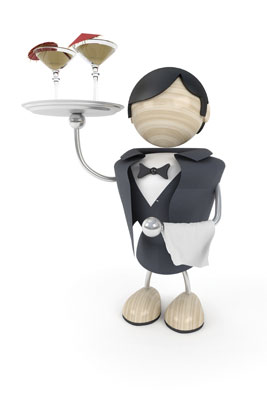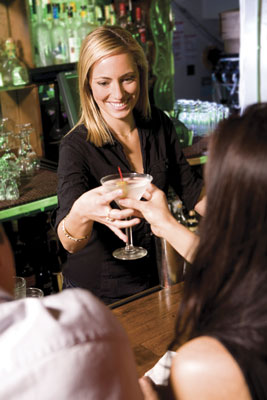During your next staff meeting, gather your bartenders and cocktail servers and ask, “What is your main responsibility here?” Most likely, the bartenders will answer, “To make drinks,” and the servers will reply, “To serve drinks.” Many front-line team members make the mistake of believing — or are trained to believe — that their job is to take and fill orders for food and drink. That perception could not be further from the truth. For truly successful people, serving and bartending is actually a sales position. 
To reinforce the importance of selling rather than simply serving, frame the benefits of adopting selling behaviors to your staff around how they can affect tip income drastically. Here are some powerful nuggets:
• Research shows that check total is the greatest influencer of tip amount, more than all other factors combined, including quality of service. Most Americans instinctively apply a standard tip percentage to the sales total with an expectation of perfect service.
• Knowing how and when to sell a second drink increases tips in increments of 100%. Who isn’t interested in doubling their income?
• Suggesting and selling premium beverages delivers even more explosive results. Sell a $10 signature cocktail instead of a $4 well drink, and you instantly have increased your tip income by 150%!
Now that you have your staff’s attention (and you will — every server and bartender I’ve ever met is coin-operated), give them some tools. Frequently, the only salesmanship technique being trained and practiced on the floor is the “upsell.” The upsell may be the most difficult sales technique available because a server must wait for a guest to make up his or her mind, then try to change it. It also delivers diminished results — 25 cents here, $1 there — hardly the explosive tip gains that will inspire a change in staff mindset and behavior.
To that end, we present a few techniques that address the timing and language of selling on the floor and deliver radically increased tips as well as sales for the business.
Language
Stop leading with “the deal.” When a customer asks, “What’s good here?” resist the temptation to simply tell them what’s on sale. Instead, tell them what you like or what the house specialty is, as well as other guests’ reactions to it. Remember, drink discounts are designed to get people in the door. Once inside, it is to your benefit to sell them full-priced signature beverages.
 When asked to recite a product list, such as which beers you carry, start at the top (specifically, the most expensive) and work your way down. Too often, a server or bartender begins at the bottom and works his or her way up the list. By the time the server mentions the seventh domestic draft, which likely is on special anyway, guests are fatigued and shout out a beer just to stop the rambling list, all before the server ever gets to the premium stuff.
When asked to recite a product list, such as which beers you carry, start at the top (specifically, the most expensive) and work your way down. Too often, a server or bartender begins at the bottom and works his or her way up the list. By the time the server mentions the seventh domestic draft, which likely is on special anyway, guests are fatigued and shout out a beer just to stop the rambling list, all before the server ever gets to the premium stuff.
Always approach with a specific suggestion. Asking, “What can I get you to drink?” does not sell premium beverages. In fact, it puts the onus on the guests, who may not be familiar with your top-of-the-line offerings and simply will settle in to their usual, less expensive choice. Always lead with a reference to your premium beverage menu or personal favorites.
When selling the second drink, avoid asking a group if they are “ready for another round.” Group ordering dynamics tend to drive sales down. This type of approach puts people in the uncomfortable position of either having to make a decision for others or to build consensus within a group, neither of which benefit the quick-decision sales cycle. Additionally, guests often perceive the offer of getting a round as a time commitment. Notice that when you ask a group if they’d like another round, someone always looks at his or her watch. It’s never a good sign if guests are looking at their watches in a bar or nightclub. The best approach is to go to each guest individually and offer another of the specific beverage they are enjoying.
Timing
When taking an order, always begin by finding the person who’s most likely to buy a premium beverage and let him or her order first. Taking orders based on seating position (starting at your right and moving around the table, etc.) leaves your tip to chance. If you simply begin with the person in “Position 1,” you are placing the group’s sales for the entire evening in his or her hands. If the guest orders a half-priced well drink, research shows that the rest of the table is more likely to order the same or something similar, even if they were predisposed to order something more expensive. Instead, take the order by suggesting a premium beverage to the table and find out who’s interested. If you can identify the guest who is predisposed to ordering a premium beverage first, the trend at the table will work more in your favor, with high-end purchases all around.
When selling a second drink, timing is crucial. Different organizations train with different approaches but nearly all are based on the content level of the guest’s first drink: i.e., suggest the next beverage when the first is half-full, or one-third full, etc. Studies show, however, that the second-drink decision is more influenced by the content level of a guest’s companions’ glasses. You may notice that, when offered a second drink, most people look at how much their companions have left to decide whether they have time to consume another beverage. Considering this, you will have more success selling to the guest with an empty glass while his or her companion’s glass is still relatively full. (Note: Be aware if a guest appears to be consuming very quickly to avoid over-service.)
Change is hard; if you want your team to sell drinks rather than simply serve drinks, you have to give them a good reason to do so. Often, when we ask our front-line teams to sell more or serve better, they hear: “I want you to work harder so I can make more money.” Most of them are not interested in helping you make more money (they likely think you make too much as it is). Phrasing salesmanship conversations around how it will benefit them and their tips will result in immediate engagement and real change. Servers and bartenders measure their success by how much they take home, not how much the bar sells, so teach them how to drive that success. Remember, the behaviors that make more money for your team are behaviors that will make more money for your business. NCB
